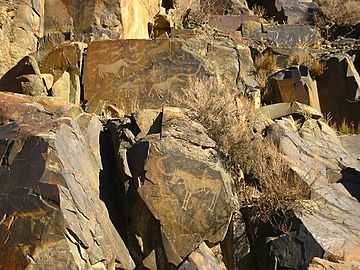Tanbaly facts for kids
| UNESCO World Heritage Site | |
|---|---|

Petroglyphs of Tamgaly
|
|
| Location | Kazakhstan |
| Criteria | Cultural: (iii) |
| Inscription | 2004 (28th Session) |
| Area | 900 ha (2,200 acres) |
| Buffer zone | 2,900 ha (7,200 acres) |
Tamgaly is a special place in Kazakhstan where you can find many ancient rock carvings. These carvings are called petroglyphs. The word Tamgaly means "painted or marked place" in the Kazakh and other Turkic languages.
This amazing site became a UNESCO World Heritage Site in 2004. This means it's a very important place that needs to be protected for everyone to see. Tamgaly is about 170 kilometers (105 miles) northwest of a big city called Almaty.
The oldest carvings at Tamgaly were made about 3,000 years ago during the Bronze Age. People who lived there before the Saka and Scythian tribes created them. The newest carvings are from the 18th or 19th century, showing that people continued to add art to these rocks for a very long time.
Contents
What are the Tamgaly Petroglyphs?
There are around 5,000 petroglyphs at Tamgaly. They are spread out across 48 different spots. Five of the most important spots, named I, II, III, IV, and V, hold about 3,000 of these carvings. These five main spots are found close together in a small canyon at Tamgaly.
Another 22 spots have between 50 and 100 carvings each. The rest of the spots have fewer carvings, from 1 to 50, and are found in a wider area. These carvings show us how people lived and what they believed in over thousands of years.
Ancient Art Through Time
The petroglyphs at Tamgaly were made during four different time periods. Each period has its own style and types of pictures.
Bronze Age Art
The carvings from the Middle Bronze Age are considered the most beautiful and important. These pictures are usually about 25 to 30 centimeters (10 to 12 inches) tall. Some very large ones can be up to 1 meter (3 feet) tall.
Artists made these by carefully pecking away at the rock. The carvings are very detailed and look natural. They show many different things:
- People with sun-like heads (called solar deities)
- People wearing costumes or masks
- Men with clubs or bows
- Hunters wearing wolf masks
- People praying or worshipping
- Warriors with weapons
- Scenes of animal and human sacrifices
- Women giving birth
- Chariots (ancient carts with wheels)
- Animals like bulls, donkeys, horses, camels, wild boars, wolves, and deer.
Some of the animals shown in these carvings are not found in this area today because they are extinct.
Later Bronze Age Carvings
Carvings from the Late Bronze Age and the time just after it are a bit simpler. They don't have as much variety. They were made by pecking the rock less deeply, only about one to two millimeters. These carvings are also smaller, usually less than 15 centimeters (6 inches).
Complex scenes are rare in this period. You can still see horses, bulls, and wild animals. But there are more pictures showing everyday life, like people looking after their animals.
Iron Age Stories
The carvings from the Early Iron Age are the most common at Tamgaly. These carvings were made by many different groups of people and tribes. Because of this, they don't all look the same in style or quality.
Common scenes from this time include:
- Hunting wild animals
- Predators chasing deer and goats.
Middle Ages and Modern Carvings
There are fewer petroglyphs from the Middle Ages and modern times, only about 300. These carvings often show warriors fighting each other. Hunting scenes focus more on the hunter than on the animal being hunted.
These later carvings also show more details about:
- Banners (flags)
- Weapons
- Horse equipment.
The figures are not carved as deeply into the rock. Many of them were added next to older carvings. They are also found in less noticeable places.
See also
 In Spanish: Tamgaly para niños
In Spanish: Tamgaly para niños
Gallery








